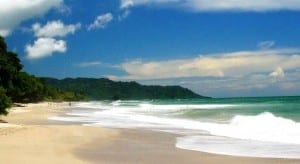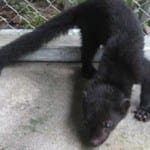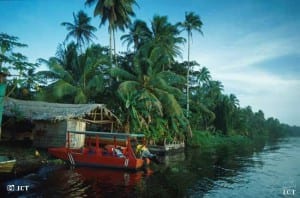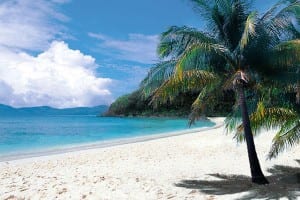A collection of small, charming luxury hotels and lodges in Costa Rica, each featuring its own original character and style – special, different, with first class services conceived for a demanding upscale tourist. We believe in good environmental hotel practices, and are committed to Costa Rica's CST certification of sustainable tourism.
lunes, 25 de noviembre de 2013
Playa Guiones by Nosara is one of the best surfing beaches in Costa Rica
Most people visiting Nosara head straight for Playa Guiones, which with its beautiful white sand and consistent surf break, is one of Costa Rica's most favored surfing beaches.
This breezy Blue-Flag beach is reputed to have the most consistent surf on Costa Rica's Pacific Coast with "surf-able waves here over 300 days a year," reports the Visit Nosara tourism website. Guiones Point at the south end of the beach juts way out into the Pacific and is a swell magnet, attracting both north and south facing swells. The sandy bottom beach break at Guiones stretches up and down the 7 km (4.5 mile) bay, with waves for every skill level – from beginner to expert, long boarder to short boarder.
Backed by lush vegetation, Playa Guiones is also a haven for sun lovers, beachcombers, joggers and anyone looking for a fun bike ride down the beach. However, it is important to note that there is a 3-meter (9-foot) tide differential, and the beach is rather narrow at high tide.
Offshore winds blow most every morning during dry season, from December until the end of April, making for great surf conditions early – most surfers are riding the waves between 7:00 a.m. and 10:00 a.m., then coming back for a sunset session if conditions allow. The wind usually switches onshore by 10:00 a.m., although there are often days during December and January when offshore breezes blow almost all day long, notes Visit Nosara.
When the big swells come in, waves at Playa Guiones can be giant and powerful, and should be taken with extreme caution; Nosara tourist information recommends only experienced surfers should paddle out in big surf. Additionally, tourist information cautions surfers during high tides, when rip currents and surf are strongest.
Just north of Playa Guiones, Playa Pelada is another pretty white-sand beach where the water is a little calmer. Waves here are better suited for beginners. There are tide pools to explore, lots of trees for shade, and it is a great spot for viewing Nosara's spectacular sunsets.
Check out the daily Nosara Surf Report, and see how the waves are in real time on the Nosara Live Cam. Surfing Nosara also provides a detailed, long- and short-range Nosara Surf Forecast.
Hotels in Nosara, Costa Rica
Located on a remote stretch of the Nicoya Peninsula in Guanacaste, just north of Samara, L'acqua Viva Resort & Spa is a luxury boutique hotel by Playa Guiones. The hotel's name means "live water," which is a key element flowing around the exotic Bali-style architecture. L'acqua Viva is part of the Enchanting Hotels group of Costa Rica.
Article by Shannon Farley
Etiquetas:
beach resort costa rica,
hotels in nosara costa rica,
playa guiones nosara,
playa nosara,
surfing beaches costa rica,
surfing costa rica
Ubicación:
Nosara, Costa Rica
Guarding the King of the Jungle on the Osa Peninsula
Like the lion or the tiger, the jaguar is the "king of the jungle" in the Americas. It is the largest feline in the Americas and the third largest in the world, notes Wikipedia. With a range extending from Southwestern United States and Mexico across much of Central America and south to Paraguay and northern Argentina, there are only an estimated 15,000 jaguars left in the wild, according to the World Wildlife Fund (WWF).
"The jaguar is still an abundant species, but is threatened by habitat loss and persecution," notes a 2008 report by the International Union for Conservation of Nature (IUCN). "Due to loss of habitat, poaching of prey and fragmentation of populations across portions of the range, this species is considered to be 'near threatened.' If threats continue at the current rate, the species will likely qualify for 'vulnerable' status in the near future."
This spotted cat most closely physically resembles the leopard, although it is usually larger and stockier, and its behavior is more similar to that of the tiger. Jaguars prefer dense rainforest for their habitat, but will range across a variety of forested and open terrains; they usually stay near water, and jaguars are noted for enjoying swimming like tigers.
In Costa Rica, the Osa Peninsula is an important refuge for the jaguar. The large cats roam between the vast Corcovado National Park, the biological corridor of the Golfo Dulce Forest Reserve, and the Piedras Blancas National Park. The biggest threat to the jaguar population is being killed by farmers, reported a 2011 article on jaguar conservation by the Tico Times. According to Eduardo Carrillo, biologist and director of the International Institute of Conservation and Wildlife at the National University (ICOMVIS-UNA) in Heredia, the conflict between farmers and jaguars has resulted from the loss of the wildcats' natural prey.
"Much of the reason that jaguars enter farms to attack cattle is because sport hunting has diminished their principal prey and sources of food in protected areas," Carrillo said. "People kill the principal prey of the jaguars and it leaves them without sufficient food. As a result, they leave the protected areas and kill cows and pigs, which results in the jaguars being killed by farmers. In Costa Rica, it is the principal cause of the decreasing population of jaguars."
In Puerto Jiménez, Yaguará (the native word for jaguar) is a non-profit, non-governmental organization that protects wildlife, mainly wild cats. They work with the community and the National Parks system to study jaguars and ensure their survival and also for their prey throughout southern Costa Rica and northern Panama. Yaguará is experimenting with alternative strategies, such as a farmer compensation program when a wildcat kills an animal.
The organization has created an extensive network of infrared "camera traps," which use motion detectors to capture on film anything that passes by the camera. Yaguará's scientists use the information to study the Osa's wildcat populations, especially those of ocelots, pumas and jaguars.
Playa Nicuesa Rainforest Lodge, across the Golfo Dulce from the Osa Peninsula, also has installed camera traps to record wildlife activity in their 165-acre private rainforest preserve. The Playa Nicuesa Reserve borders the Piedras Blancas National Park, which connects to the Osa Peninsula and Corcovado National Park, so it is feasible that they could capture on camera the same jaguars that roam the Osa.
Playa Nicuesa Rainforest Lodge is an environmentally sustainable lodge on the pristine Pacific coastline of the Golfo Dulce. The award-winning eco-lodge caters to travelers interested in ecotourism, nature and adventure. They offer family vacations, honeymoon trips, nature and adventure vacations, and yoga classes and retreats.
Go for the Guanacaste cowboy life at Hacienda Guachipelin.
It is said in Costa Rica that the best "all-terrain vehicle" for navigating the country is a horse. Costa Ricans love horses and their riding traditions – their equestrian roots coming from the Spanish who brought horses with them to Central America in the 16th century.
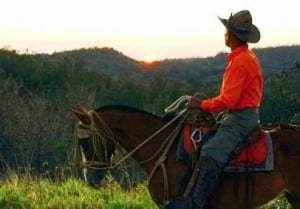 The northwestern province of Guanacaste is the heart and soul of Costa Rica's equestrian life. Here, vast rolling plains, towering volcanoes and mountains, and a sunny, dry and hot climate of the dry tropical forest create perfect ranching conditions. For generations, Guanacaste has been dedicated to working the land, and cattle and horse ranching. Even though the region's main economic activity is now tourism, the traditions of "sabanero" (cowboy) folklore, customs, music and dance are deeply rooted.
The northwestern province of Guanacaste is the heart and soul of Costa Rica's equestrian life. Here, vast rolling plains, towering volcanoes and mountains, and a sunny, dry and hot climate of the dry tropical forest create perfect ranching conditions. For generations, Guanacaste has been dedicated to working the land, and cattle and horse ranching. Even though the region's main economic activity is now tourism, the traditions of "sabanero" (cowboy) folklore, customs, music and dance are deeply rooted.
In the golden savanna at the base of the Rincon de la Vieja Volcano, Hacienda Guachipelin Hotel is a working horse and cattle ranch, in addition to being an active eco-tourism hotel. In the 19th century, the immense Hacienda ranch once stretched from the tip of the Rincón de la Vieja Volcano all the way to the Pacific Ocean. Since 1975, Tomás Batalla Esquivel, a renowned cattle rancher and purebred Spanish horse breeder, has been keeping the ranching legacy alive with his family.
 Today, the property measures nearly 3,400 acres and includes conservation areas for tropical dry forest and endangered native tree species. Hacienda Guachipelin offers seven different horseback riding tours riding the trusty ranch horses on scenic forest trails to the Rincon de la Vieja National Park or waterfalls or natural thermal springs. There is even a "Cowboy for a Day" tour, where you help out the real ranch cowboys in the stables and corral, milk cows, saddle and ready the horses, and ride out to herd cattle or other horses.
Today, the property measures nearly 3,400 acres and includes conservation areas for tropical dry forest and endangered native tree species. Hacienda Guachipelin offers seven different horseback riding tours riding the trusty ranch horses on scenic forest trails to the Rincon de la Vieja National Park or waterfalls or natural thermal springs. There is even a "Cowboy for a Day" tour, where you help out the real ranch cowboys in the stables and corral, milk cows, saddle and ready the horses, and ride out to herd cattle or other horses.
For an authentic experience of Guanacaste culture, and an active vacation at the Rincón de la Vieja Volcano, Hacienda Guachipelín Hotel is an ideal place to stay. The first-class ecotourism lodge offers thrilling canopy ziplines, canyoning, waterfall rappelling, river tubing, horseback riding, nature trails, mountain biking and thermal springs.
Article by Shannon Farley
sábado, 23 de noviembre de 2013
viernes, 22 de noviembre de 2013
jueves, 21 de noviembre de 2013
Discover the magic of Costa Rica’s South Caribbean Coast
Costa Rica's south Caribbean Coast is a magical place. South of Limon, the southern Caribbean beach towns of Cahuita, Puerto Viejo and Manzanillo are ideal destinations for a Costa Rica vacation. Puerto Viejo is the most developed area with a thriving multicultural community, international restaurants, and a diverse array of hotels.
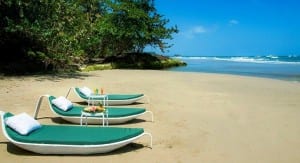 Not as well traveled, simply because Costa Rica's larger Pacific Coast gets most of the attention, the southern Caribbean keeps a quieter, more peaceful tone. Surfers know about Cahuita, Puerto Viejo and Gandoca, renowned for their great waves. Scuba divers and snorkelers certainly know about the marvels of the crystal-clear Caribbean Sea and coral reefs at the Cahuita National Park and offshore from the Gandoca-Manzanillo National Wildlife Refuge.
Not as well traveled, simply because Costa Rica's larger Pacific Coast gets most of the attention, the southern Caribbean keeps a quieter, more peaceful tone. Surfers know about Cahuita, Puerto Viejo and Gandoca, renowned for their great waves. Scuba divers and snorkelers certainly know about the marvels of the crystal-clear Caribbean Sea and coral reefs at the Cahuita National Park and offshore from the Gandoca-Manzanillo National Wildlife Refuge.
Beach lovers delight in having the black and golden sands on the beaches almost to themselves.
 Le Caméléon ("The Chameleon") is one of the finest hotels on Costa Rica's Caribbean Coast that caters to upscale travelers. The unique boutique hotel with a relaxed vibe is across the street from the beautiful golden sand Playa Cocles, where the hotel has a private beach club.
Le Caméléon ("The Chameleon") is one of the finest hotels on Costa Rica's Caribbean Coast that caters to upscale travelers. The unique boutique hotel with a relaxed vibe is across the street from the beautiful golden sand Playa Cocles, where the hotel has a private beach club.
Le Caméléon blends steamy jungle with modern architectural design. The hotel's decor is pure white with lively splashes of color in cushions, wall paintings, and strategically-placed colored LED lights. Like a chameleon, these decorative elements change every day. Guest rooms follow the theme, being bright white with vividly hued wall hangings, bathmats, towels and bed pillows that rotate colors daily.
At Le Caméléon, an Enchanting Hotel Costa Rica, you will enjoy a serene and relaxing experience in the rainforest, while being pampered in sophisticated warmth with a sense of fun.
Article by Shannon Farley
miércoles, 20 de noviembre de 2013
martes, 19 de noviembre de 2013
How travel keeps you feeling young - free and happy.
We all love things that make us feel young (or remember our youth), feel free and be happy. Traveling is almost always in the top 10 – even if only to an old neighborhood where we once lived. Why?
In today's world, where emails and smart phones often replace face-to-face interaction, traveling makes us get out and connect with humanity. Traveling changes our scenery. When we travel, we leave our daily routine and see new things which stimulate our mind and encourage creative energy.
2. Traveling teaches us to relax.
Whether we want to or not at first, we have to chill out to really enjoy traveling. Traveling for pleasure rejuvenates us physically and mentally so we can return to our daily routine with more energy and patience. Taking a break from our routine – work, school, daily to-dos of parenthood, household chores, etc. – refreshes our mind and gives us the freedom we need to renew.
Traveling by its very nature makes us move. Whether we're exploring a museum, walking the streets of an ancient capital, shopping in a bazaar, hiking in the woods, or simply lying on a sunny beach in Costa Rica, we are being active. New places may make us want to try new activities … ziplining or waterfall rappelling, anyone? Besides being good for our bodies, physical exercise is also good for our brains. Mental stimulation, especially languages, improves brain function and protects against age-related losses in memory or motor skills. In other words, "use it or lose it."
4. Traveling helps us to discover new things.
Traveling is education through experience. Travel brings to life things books only describe, no matter how well. When we travel, we learn there are many different ways of thinking and that other people have their own customs of living and doing things that work equally just as well. Traveling the globe makes us lifelong learners.
Travel teaches humility. When we travel, we are often at the mercy of needing help from others. A kind, open, humble attitude gets us much farther than nastiness and arrogance. As we travel more, we learn that language, customs and exterior differences aside, that people share the same basic desires and concerns. We start to see that the world is both a big and small place, and how interconnected we all really are.
6. Traveling teaches appreciation – for home, loved ones, good food, good company, beautiful sights, art, music, freedom, your blessings … and the list is endless.
The laid-back beach town of Santa Teresa is near the southern tip of the Nicoya Peninsula on Costa Rica's Pacific Coast. Mal Pais, Playa Carmen, Santa Teresa and Playa Hermosa – once secret hideaways for surfers and backpackers are now popular beaches sprinkled with eco-lodges, beach bungalows and upscale luxury boutique hotels. Yet, this multinational paradise with world-class surf breaks remains off-the-beaten path.
Pranamar Oceanfront Villas & Yoga Retreat is a relaxing oasis on the beach at Santa Teresa, with elaborate oceanfront villas and tropical bungalows in lush tropical gardens. Designed in exotic Bali-style, the luxury boutique hotel gives daily in-house yoga classes, and all-inclusive yoga vacations and surfing holidays.
Article by Shannon Farley
45 new butterfly species discovered in Costa Rica.
In the case of butterflies, it pays to look like your neighbor.
New information about long-winged butterflies in Costa Rica is showing how the importance of "mimicry" and the butterflies' natural promiscuity has led to interbreeding and the creation of new species that look very much alike, according to a study led by University of Chicago evolutionary biologist, Marcus R. Kronforst.
butterflies' natural promiscuity has led to interbreeding and the creation of new species that look very much alike, according to a study led by University of Chicago evolutionary biologist, Marcus R. Kronforst.
"In evolutionary biology, mimicry is the similarity of one species to another which protects one or both.This similarity can be in appearance, behavior, sound, scent and location, with the mimics found in similar places to their models," notes Wikipedia.
Mimicry, or looking like another, is important to butterflies to avoid being a tasty snack for birds and other predators. If a tasty or non-venomous butterfly is confused with a bad-tasting or toxic butterfly, both species will go unmolested and be more likely to survive.
 Take, for example, the Viceroy butterfly (Limenitis archippus) which mimics the Monarch Butterfly (Danaus plexippus) in shared orange and black coloration patterns. While the Viceroy butterfly isn't incredibly appetizing to birds, it is not highly toxic like the Monarch; yet because they look alike, predators tend to leave both alone.
Take, for example, the Viceroy butterfly (Limenitis archippus) which mimics the Monarch Butterfly (Danaus plexippus) in shared orange and black coloration patterns. While the Viceroy butterfly isn't incredibly appetizing to birds, it is not highly toxic like the Monarch; yet because they look alike, predators tend to leave both alone.
The long-winged Heliconius butterflies are the species in the study whipping up interest. The butterflies, including one known as the "Costa Rican postman," have bright orange markings on their wings and are toxic. Promiscuous habits have led to the creation of up to 45 new species from the butterflies' interbreeding, scientists report. The interesting thing the geneticists have discovered is that all of the species resemble one another (Mullerian mimicry) with slight differences, which has led to shared survival tactics by baffling predators into avoiding a range of wing patterns.
The Butterfly Garden at Veragua Rainforest Research & Adventure, in Costa Rica's Caribbean rainforest, is inhabited by some of the most colorful butterflies in the world, including the noteworthy Heliconius butterflies. A tour at the 1,300 hectare (3,212 acre) biology research center and adventure park lets you walk through an immense live butterfly garden, plus visit a research lab where staff scientists study the behavior and lifestyle of these vivid flying insects.
 Veragua Rainforest Research & Adventure is located in the Talamanca Mountain Range about an hour inland from Costa Rica's Caribbean port of Limón. Veragua Rainforest is an excellent one-day tour in the Costa Rica rainforest. Attractions include wildlife exhibits and science labs, an aerial tram, canopy zipline tour, rainforest hiking trails, a river with waterfalls, and a restaurant, café and souvenir shop.
Veragua Rainforest Research & Adventure is located in the Talamanca Mountain Range about an hour inland from Costa Rica's Caribbean port of Limón. Veragua Rainforest is an excellent one-day tour in the Costa Rica rainforest. Attractions include wildlife exhibits and science labs, an aerial tram, canopy zipline tour, rainforest hiking trails, a river with waterfalls, and a restaurant, café and souvenir shop.
Article by Shannon Farley
Etiquetas:
butterfly garden costa rica,
Caribbean costa rica,
costa rica butterflies,
costa rica ecotours,
costa rica rainforest,
limon costa rica,
things to do in puerto limon
Ubicación:
Limón, Costa Rica
viernes, 15 de noviembre de 2013
Chill out in tropical paradise in Nosara, Costa Rica.
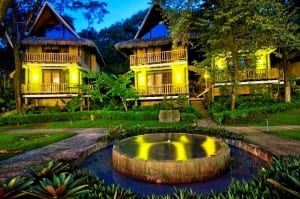 Thatched-roof pavilions in jungle gardens, hidden courtyards reflecting pools and temple carvings, covered open-air walkways, wide verandas and smooth wooden decks, living spaces that invite the landscape inside … these are all elements of the world-wide architectural phenomenon known as "Bali Style."
Thatched-roof pavilions in jungle gardens, hidden courtyards reflecting pools and temple carvings, covered open-air walkways, wide verandas and smooth wooden decks, living spaces that invite the landscape inside … these are all elements of the world-wide architectural phenomenon known as "Bali Style."
The mere mention of Bali evokes thoughts of tropical paradise. Bali is more than a small Indonesian island; it's a tropical state of mind. That "Shangri-La" vision has carried Bali's rich imagery far and wide in modern tropical architecture, furniture, art, and garden landscaping.
Tropical architecture design works with the elements of nature to achieve living comfort in hot, humid and wet climates. Balinese design is known for mirroring and blending in with its surroundings. Wood, bamboo and natural stone are used generously, earth tones dominate, and steeply pitched thatched or clay-tiled roofs with big overhangs help protect interior spaces from the tropical sun's brightness, as well as gushing rain showers. Living spaces open to gorgeous, lush green gardens, lofty mountains, or beautiful coastlines. The spirit world is very important in Bali, and their homes call to mind relaxing, meditative energy.
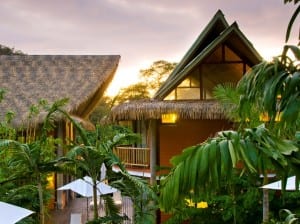 To simulate Bali's beautiful landscapes, this highly-popular architectural style uses inner courtyards set off by wooden decks, pools and water features – creating a harmonious relationship with nature.
To simulate Bali's beautiful landscapes, this highly-popular architectural style uses inner courtyards set off by wooden decks, pools and water features – creating a harmonious relationship with nature.
Bali-style architecture is exceptionally popular in tropical Costa Rica. A spectacular example of Bali-style architecture is L'acqua Viva Resort & Spa at Playa Guiones, by Nosara on the Nicoya Peninsula. L'acqua Viva means "live water," which is a key element flowing throughout the property. Hotel buildings and guest suites seem to float on abundant water mirrors, ponds and pools. Triangular pitched roofs sport wide thatched overhangs. A large elevated wooden deck by the pool provides space for sunning, along with shaded areas for when you need a rest from the heat.
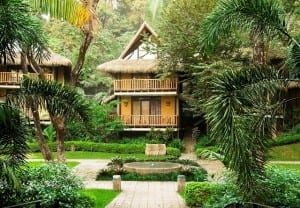 L'acqua Viva Resort & Spa is located one kilometer from the fine white sand beach of Playa Guiones, known for great Costa Rica surfing. L'acqua Viva is part of the Enchanting Hotels group of Costa Rica. The best way to reach Nosara and Playa Guiones is to take a domestic flight from San Jose or Liberia to the Nosara domestic airport.
L'acqua Viva Resort & Spa is located one kilometer from the fine white sand beach of Playa Guiones, known for great Costa Rica surfing. L'acqua Viva is part of the Enchanting Hotels group of Costa Rica. The best way to reach Nosara and Playa Guiones is to take a domestic flight from San Jose or Liberia to the Nosara domestic airport.
Article by Shannon Farley
Etiquetas:
Bali architecture,
Bali design,
beach resort costa rica,
hotels in nosara costa rica,
playa guiones nosara,
spa hotels costa rica,
tropical architecture
Ubicación:
Nosara, Costa Rica
Hotel Punta Islita wins four top travel awards in 2013
 Hotel Punta Islita on the Nicoya Peninsula, one of Costa Rica's most awarded hotels, recently gained yet another feather in its cap by being inducted into the travel world's prestigious "Autograph Collection" by Marriott International. The Costa Rica boutique hotel is the 50th luxury hotel in the world, and the first in Central America, to be added to the exclusive portfolio that prizes travel properties for their uniqueness, elegance, top-of-the-line service, and corporate social responsibility.
Hotel Punta Islita on the Nicoya Peninsula, one of Costa Rica's most awarded hotels, recently gained yet another feather in its cap by being inducted into the travel world's prestigious "Autograph Collection" by Marriott International. The Costa Rica boutique hotel is the 50th luxury hotel in the world, and the first in Central America, to be added to the exclusive portfolio that prizes travel properties for their uniqueness, elegance, top-of-the-line service, and corporate social responsibility.
Hidden away on a remote stretch of Costa Rica's Nicoya Peninsula, overlooking a white sand beach and an azure cove on the Pacific Ocean, Hotel Punta Islita is like no other Costa Rica hotel. Its off-the-beaten-path destination caters to sophisticated travelers and allows you to slow down, deeply relax, and really enjoy your Costa Rica vacation or honeymoon.
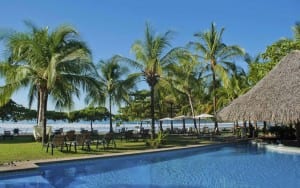 The list of Hotel Punta Islita's awards is long and impressive. In just 2013, Hotel Punta Islita was named one of the Best 100 Hotels in the World by Travel & Leisure Magazine, chosen for the Gold List by Condé Nast Traveler Magazine, and given a Traveler's Choice Award by TripAdvisor.
The list of Hotel Punta Islita's awards is long and impressive. In just 2013, Hotel Punta Islita was named one of the Best 100 Hotels in the World by Travel & Leisure Magazine, chosen for the Gold List by Condé Nast Traveler Magazine, and given a Traveler's Choice Award by TripAdvisor.
Holding the maximum level in the Costa Rican Tourism Board's (ICT) Certification for Sustainable Tourism Program, the five-star eco-hotel showcases the unique design of prominent Costa Rican architect, Ronald Zurcher. The hotel cascades down a hilltop in tiers to the Islita Beach, where their private beach club is located. On Hotel Punta Islita's 300 acres, there is an executive nine-hole golf course, tennis courts, spa, conference room and two restaurants. The hilltop infinity-pool is one of the most spectacular features.
To stay at Hotel Punta Islita, you have the choice between luxury rooms and suites or private villas.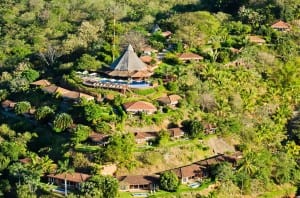

Just because Hotel Punta Islita is secluded, that doesn't mean that it's isolated from the surrounding Costa Rican community. Nearby, you can enjoy Costa Rica eco-adventures like river kayaking, canopy ziplines, wildlife-spotting safaris, night-time sea turtle watching excursions, or bird-watching hikes led by local naturalist guides. The hotel has a private landing strip for small commuter aircraft, with commercial flights operating from San Jose on a regular schedule throughout the year.
Costa Rica Guides can help you with your Costa Rica vacation plans and to make reservations at Hotel Punta Islita. Operated by Expediciones Tropicales, a Costa Rica travel agency with more than 18 years of experience, Costa Rica Guides, assists with hotel reservations, Costa Rica tours, Costa Rica vacation packages, private transportation, rental cars, shuttle services, local flights, and information on what to do, where to go and what to see while you're in Costa Rica.
Article by Shannon Farley
Etiquetas:
costa rica luxury boutique hotels,
Costa Rica travel,
costa rica travel planning,
eco-hotels costa rica,
Nicoya Peninsula hotels,
vacations costa rica
Ubicación:
Costa Rica
martes, 12 de noviembre de 2013
What to do for nature and adventure vacations in Costa Rica.
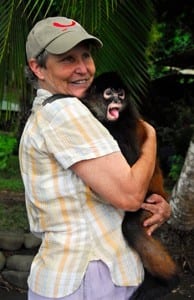 Meet sloths, kinkajous, tayras, ocelots, peccaries and anteaters. Stand next to Scarlet Macaws feeding on almond trees. Watch white-faced monkeys swing and play next to you, and have your heart melt when a spider monkey comes to hold your hand.
Meet sloths, kinkajous, tayras, ocelots, peccaries and anteaters. Stand next to Scarlet Macaws feeding on almond trees. Watch white-faced monkeys swing and play next to you, and have your heart melt when a spider monkey comes to hold your hand.
This isn't some exotic zoo, but rather the Osa Wildlife Sanctuary on Golfo Dulce in the South Pacific of Costa Rica. The Costa Rica wildlife refuge helps orphaned and injured animals that are indigenous to this southern Pacific rainforest. Sadly, many of the animals are victims of illegal pet trade.
Monkeys, wild cats, kinkajous, Scarlet Macaws and other prized creatures are captured as babies, and then abused or abandoned when their owners find they don't know how to deal with a wild animal. The Osa Wildlife Sanctuary works closely with the Costa Rica Ministry of Environment and Energy (MINAE) to rescue illegally-held animals.
The sanctuary on the beautiful Golfo Dulce coast by the Piedras Blancas National Park was originally an eco-lodge started by owners Carol Patrick and Earl Crews. Carol got a reputation for tending to injured animals, and soon locals began dropping off orphaned and injured wildlife until there was no time for guests. The Osa Wildlife Sanctuary was then established in 1996.
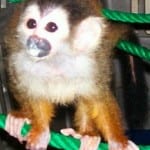 At first primarily an avian sanctuary, after Poppy the spider monkey arrived in 2003, all sorts of wonderful critters started showing up. Carol and her staff try their best to rehabilitate animals to release back into the wild. For each animal that enters the refuge, a complex and often unconventional playground, specifically designed to mimic its natural habitat, is created for housing. Environmental enrichment features – like species-appropriate toys, imitation streams with cascading water, and tree branches –encourage natural behaviors and prevent boredom.
At first primarily an avian sanctuary, after Poppy the spider monkey arrived in 2003, all sorts of wonderful critters started showing up. Carol and her staff try their best to rehabilitate animals to release back into the wild. For each animal that enters the refuge, a complex and often unconventional playground, specifically designed to mimic its natural habitat, is created for housing. Environmental enrichment features – like species-appropriate toys, imitation streams with cascading water, and tree branches –encourage natural behaviors and prevent boredom.
The Osa Wildlife Sanctuary is a non-profit organization and relies on donations and tour fees to help with expenses like food, staffing, veterinary medical care, and supplies. Guided tours for visitors cost $25 per person and reservations must be made in advance.
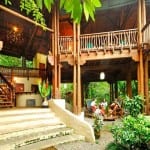 The animal refuge is a popular eco-tour for guests at Playa Nicuesa Rainforest Lodge, just 10 minutes away by boat down the Golfo Dulce coast. Playa Nicuesa Rainforest Lodge is an environmentally sensitive eco-lodge set on a 165-acre private preserve.
The animal refuge is a popular eco-tour for guests at Playa Nicuesa Rainforest Lodge, just 10 minutes away by boat down the Golfo Dulce coast. Playa Nicuesa Rainforest Lodge is an environmentally sensitive eco-lodge set on a 165-acre private preserve.
The award-winning eco-lodge caters to travelers interested in ecotourism, nature and adventure. They offer family vacations, honeymoon trips, nature and adventure vacations, and yoga classes and retreats.
Article by Shannon Farley
lunes, 11 de noviembre de 2013
Tortuguero, Costa Rica Where the wild things are
 The Tortuguero coast in Costa Rica is a 22-mile-long, desolate, volcanic black sand beach littered with driftwood and tree logs tossed up on shore from the untamed ocean.
The Tortuguero coast in Costa Rica is a 22-mile-long, desolate, volcanic black sand beach littered with driftwood and tree logs tossed up on shore from the untamed ocean.
It is a wild place – like the imaginary jungle coast in Maurice Sendak's "Where the Wild Things Are." There is nothing but beach and low, swampy jungle for miles and miles. You can't swim here because of rough surf, strong currents and sharks that will eat you – adding to the isolation.
Known as Costa Rica's "little Amazon" for its completely wild and dense tropical lowland rainforest, and serpentine maze of canals and lagoons, Tortuguero on the northern Caribbean Coast is a special and widely varied ecosystem. If you enjoy nature, Tortuguero is an un-missable destination on a Costa Rica vacation.
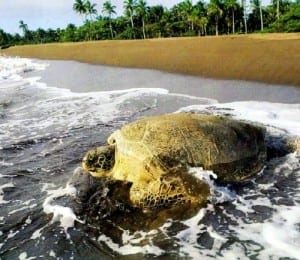 Tortuguero is famous for being the Western Hemisphere's most important nesting site for the endangered Green sea turtle, and a major nesting site for the critically endangered Hawksbill and Leatherback sea turtles. According to scientific records, the turtles have been recorded coming here since at least 1592 to nest and hatch their young in Tortuguero's extreme solitude.
Tortuguero is famous for being the Western Hemisphere's most important nesting site for the endangered Green sea turtle, and a major nesting site for the critically endangered Hawksbill and Leatherback sea turtles. According to scientific records, the turtles have been recorded coming here since at least 1592 to nest and hatch their young in Tortuguero's extreme solitude.
The name "Tortuguero" means "turtle catcher" in Spanish, and the turtle population came perilously close to extinction in the 1960s from hunting. Renowned sea turtle expert and ecologist, Dr. Archie Carr, founded the Caribbean Conservation Corporation, now known as the Sea Turtle Conservancy, in 1959 to study and protect the sea turtles. Soon after, in 1970, Costa Rica created the Tortuguero National Park to preserve more than 46,900 acres 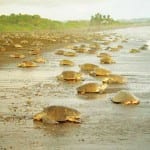 (19,000 hectares), along with the 22 miles of nesting beach, making it one of the largest remaining lowland wet tropical forests in the country.
(19,000 hectares), along with the 22 miles of nesting beach, making it one of the largest remaining lowland wet tropical forests in the country.
 (19,000 hectares), along with the 22 miles of nesting beach, making it one of the largest remaining lowland wet tropical forests in the country.
(19,000 hectares), along with the 22 miles of nesting beach, making it one of the largest remaining lowland wet tropical forests in the country.
The giant Leatherback sea turtles come ashore to nest from March to July; Hawksbill turtles nest from May to November, and the Green sea turtles arrive en masse by the thousands to nest from July to October. Sixty days or so later, the turtle eggs hatch and thousands of tiny four-inch-long sea turtle babies emerge all together and race to the sea. Visitors to the area go on guided tours to see the turtles since no one is allowed unaccompanied on the beaches after 6:00 p.m. to prevent poaching.
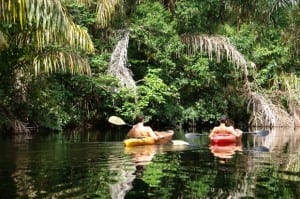 To see the rest of Tortuguero National Park, the best way is by boat or kayak along its canals through the labyrinth of islets, which are home to more than 50 species of amphibians, 100 kinds of reptiles, 300 types of birds and 60 species of mammals. If you are exceptionally lucky, you may even spot an endangered West Indian Manatee that populates these waters.
To see the rest of Tortuguero National Park, the best way is by boat or kayak along its canals through the labyrinth of islets, which are home to more than 50 species of amphibians, 100 kinds of reptiles, 300 types of birds and 60 species of mammals. If you are exceptionally lucky, you may even spot an endangered West Indian Manatee that populates these waters.
Travel to Tortuguero
Valle Dorado Tours in Costa Rica offers a 3-day, 2-night Tortuguero vacation package, as well as custom travel itineraries to Tortuguero. Due to the remoteness of the area, most lodges and tour packages include all meals, transportation to and from San Jose, and tours. Top Costa Rica travel agency Valle Dorado Tours works with three of the best lodges in the area:
Getting to Tortuguero:
The only way to travel to Tortuguero is either by land and then boat (usually via one of the lodges), or by air to the small airstrip near Tortuguero Village. Only Nature Air flies to Tortuguero from San Jose.
Article by Shannon Farley
Etiquetas:
costa rica vacations,
custom travel costa rica,
ecoadventure costa rica,
nature tours costa rica,
sea turtle nesting costa rica,
tortuguero costa rica
Ubicación:
Tortuguero, Colorado, Costa Rica
Tortuguero, Costa Rica: Where the wild things are
See top Costa Rica destinations Arenal Volcano, Manuel Antonio
Almost the end of the year – are you looking for a quick getaway vacation?
Before the holiday season gets going, escape for a week to sunny Costa Rica on a seven-day Tropical Paradise Vacation. This really good travel deal from Costa Rica Special Deals is priced at only $365 USD per person (based on double occupancy). You get three nights in the rainforest at majestic Arenal Volcano and three nights on the beach at gorgeous Manuel Antonio.
 Impressive, towering Arenal Volcano in Costa Rica is always a top place to visit. Rising above the rainforest and the nearby beautiful Lake Arenal, the volcano's perfect cone shape makes a stunning sight. The famous volcano isn't spewing lava every day and night like it used to, but it is still rumbling and puffing out plumes of gas. It is a thrilling experience to be close to an active volcano, one of the planet's primal forces that shaped the earth as we know it today.
Impressive, towering Arenal Volcano in Costa Rica is always a top place to visit. Rising above the rainforest and the nearby beautiful Lake Arenal, the volcano's perfect cone shape makes a stunning sight. The famous volcano isn't spewing lava every day and night like it used to, but it is still rumbling and puffing out plumes of gas. It is a thrilling experience to be close to an active volcano, one of the planet's primal forces that shaped the earth as we know it today.
Stay three nights at Arenal Paraiso Hotel, located directly in front of the Arenal Volcano so you won't miss any of the action. The hotel's abundance of onsite outdoor activities make it an excellent choice – canopy zipline tour, horseback riding, nature trails and hot spring pools.
After the mountains, it's beach time. The lushly forested Manuel Antonio Beach glitters jade green and turquoise on the Pacific Ocean – a jewel on Costa Rica's Central Pacific Coast. Monkeys jump through the trees, dolphins and humpback whales swim offshore, and wildlife packs the renowned Manual Antonio National Park, named one of the world's most beautiful national parks by Forbes Magazine.
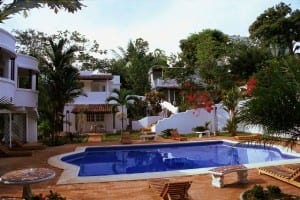 Casitas Eclipse Hotel is your luxury home for three nights in Manuel Antonio. The Mediterranean-style hotel is strategically located on a hilltop next to the Manuel Antonio National Park, which means you get occasional visits of monkeys, iguanas, sloths, exotic birds, rainforest frogs and other wildlife. For adventurers, there is plenty to do at Manuel Antonio – canopy ziplines, waterfall rappelling, whitewater rafting, catamaran sailing, sea kayaking, snorkeling, scuba diving, parasailing, horseback riding, hiking, and nature tours.
Casitas Eclipse Hotel is your luxury home for three nights in Manuel Antonio. The Mediterranean-style hotel is strategically located on a hilltop next to the Manuel Antonio National Park, which means you get occasional visits of monkeys, iguanas, sloths, exotic birds, rainforest frogs and other wildlife. For adventurers, there is plenty to do at Manuel Antonio – canopy ziplines, waterfall rappelling, whitewater rafting, catamaran sailing, sea kayaking, snorkeling, scuba diving, parasailing, horseback riding, hiking, and nature tours.
Contact Costa Rica Special Deals to take advantage of this great 7-day Tropical Paradise Vacation deal to Costa Rica. You have included all six nights in Costa Rica hotels, a car rental for seven days with unlimited mileage, and breakfast every day at your hotel. The Costa Rica-based travel service, Costa Rica Special Deals, offers competitive Costa Rica hot deals.
Article by Shannon Farley
Etiquetas:
arenal volcano costa rica,
deals costa rica,
Manuel Antonio Costa Rica,
travel deals costa rica,
vacation packages costa rica
Ubicación:
Costa Rica
viernes, 8 de noviembre de 2013
Visit Santa Teresa on a 7-day Costa Rica beach vacation.
I think Jimmy Buffet said it best: "With these changes in latitudes, changes in attitudes, nothing remains quite the same."
There is a definite change in attitude traveling to Costa Rica on vacation. A slow in the pace, relax of the heartbeat, and a desire to kick back and soak in the sun on a beautiful tropical beach.
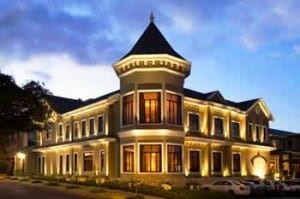 Like Margaritaville, cocktails and dreams take the stage in a seven-day spectacular Costa Rica beach vacation package by 2Costa Rica Travel agency. The "Cocktails & Dreams" package vacation gives you one night in luxury in the capital city of San Jose, and five nights of bliss at Central America's "number one beach" Santa Teresa.
Like Margaritaville, cocktails and dreams take the stage in a seven-day spectacular Costa Rica beach vacation package by 2Costa Rica Travel agency. The "Cocktails & Dreams" package vacation gives you one night in luxury in the capital city of San Jose, and five nights of bliss at Central America's "number one beach" Santa Teresa.
The day you arrive to Costa Rica, you'll stay close by the Juan Santamaria International Airport (SJO) at the stylish luxury boutique hotel Grano de Oro, housed in a restored Victorian mansion. Set just off the main boulevard of Paseo Colon in San Jose, it is an ideal location for exploring the cultural diversity of the vibrant capital.
 In the morning, you'll jet right to the Nicoya Peninsula, saving precious time on a 35-minute domestic flight to Tambor, due west on the Pacific Coast from San Jose. A scenic one hour drive later, and you'll be in paradise at Santa Teresa Beach. Your oasis on gleaming white sands by the bright blue Pacific Ocean is the luxury boutique hotel Flor Blanca. In this remote area of the southern Nicoya Peninsula, the exotically beautiful beachfront hotel rests on seven acres of thick jungle by the sea. With only 11 villas, each with an ocean view and private deck, Flor Blanca Hotel is one of the most romantic and private hotels in Costa Rica.
In the morning, you'll jet right to the Nicoya Peninsula, saving precious time on a 35-minute domestic flight to Tambor, due west on the Pacific Coast from San Jose. A scenic one hour drive later, and you'll be in paradise at Santa Teresa Beach. Your oasis on gleaming white sands by the bright blue Pacific Ocean is the luxury boutique hotel Flor Blanca. In this remote area of the southern Nicoya Peninsula, the exotically beautiful beachfront hotel rests on seven acres of thick jungle by the sea. With only 11 villas, each with an ocean view and private deck, Flor Blanca Hotel is one of the most romantic and private hotels in Costa Rica.
During your five days and nights, enjoy world-class surfing, yoga, massage, gourmet cuisine, nature walks and other fun adventure tours ... and plenty of cocktails and dreaming.
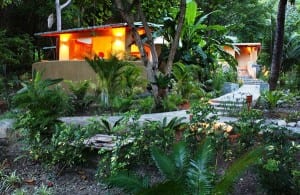 On your last day of your week-long Costa Rica beach vacation, you will hop a quick flight back to the San Jose international airport to meet your flight home.
On your last day of your week-long Costa Rica beach vacation, you will hop a quick flight back to the San Jose international airport to meet your flight home.
2Costa Rica Travel agency uses their 20+ years of experience to create amazing vacation packages to Costa Rica. Find out all the best travel information on hotels, tours and transportation in Costa Rica from 2Costa Rica Travel.
Article by Shannon Farley
Etiquetas:
Costa Rica beach vacation,
Costa Rica vacation package,
honeymoon costa rica,
nicoya península costa rica,
santa teresa costa rica hotels,
travel costa rica,
vacation costa rica
Ubicación:
Costa Rica
jueves, 7 de noviembre de 2013
New Portasol residents help save red-eyed tree frogs.
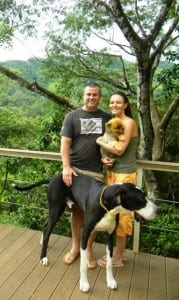 From the concrete jungle of Johannesburg, South Africa, to the wilds of the Costa Rican rainforest is quite a change. Two months ago, South African couple Gary Kritzinger and Shayne Mrazek left behind electric fences and heavy security, hour-long 6 km commutes, and a metropolitan beehive of 12 million people, for a different kind of jungle where their closest neighbors are tree frogs and toucans.
From the concrete jungle of Johannesburg, South Africa, to the wilds of the Costa Rican rainforest is quite a change. Two months ago, South African couple Gary Kritzinger and Shayne Mrazek left behind electric fences and heavy security, hour-long 6 km commutes, and a metropolitan beehive of 12 million people, for a different kind of jungle where their closest neighbors are tree frogs and toucans.
"We just wanted to get out of the rat race and be closer to nature," Kritzinger said.
The couple's dream started last November when Kritzinger visited Costa Rica for a philanthropic vacation. He fell in love with the profusion of nature, and the couple returned early this year to seek their new paradise. After combing the Pacific Coast, they found home at the sustainable eco-community of Portasol Rainforest & Oceanview Living, on Costa Rica's Central Pacific Coast between Manuel Antonio and Dominical.
"We thought, 'this is something really special,'" commented Kritzinger about first visiting Portasol. "I like the fact that it is not in the hustle and bustle. It's secure; it's well looked after, has good infrastructure, and we love the strong conservation ethic. This place is paradise and we couldn't believe that you can buy land in such an amazing place at such a steal of a price!"
Kritzinger and Mrazek bought four acres with ocean views, giant trees, and a river and two streams running through it. "It's like what I would imagine the Garden of Eden to be. It is lush and beautiful, and very private and secluded," Kritzinger mused. The couple plans to build a holiday rental, and is leasing one of Portasol's luxury vacation homes in the meantime.
 With their two dogs and two cats – a third local feline has since joined the family – Mrazek and Kritzinger began living at Portasol in September. They've jumped into rainforest living completely, starting their own "rescue project" for the red-eyed tree frog (Agalychnis callidryas) at Portasol. Upon moving in to Casa Monos Locos vacation home, they noticed clutches of eggs being deposited on the outer house wall. Being wildlife lovers and very inquisitive, they found a bright green red-eyed tree frog on another nearby wall, put two and two together and started saving the eggs.
With their two dogs and two cats – a third local feline has since joined the family – Mrazek and Kritzinger began living at Portasol in September. They've jumped into rainforest living completely, starting their own "rescue project" for the red-eyed tree frog (Agalychnis callidryas) at Portasol. Upon moving in to Casa Monos Locos vacation home, they noticed clutches of eggs being deposited on the outer house wall. Being wildlife lovers and very inquisitive, they found a bright green red-eyed tree frog on another nearby wall, put two and two together and started saving the eggs.
"How it works in nature is the frogs will go near a stream or pond and lay their eggs on a leaf above it; then the hatching tadpoles will drop in the water to swim and turn into frogs," explained Mrazek, who researched the frogs on the internet with Kritzinger. "The swimming pool by the house wall was confusing the frogs. We thought it was better to save the eggs rather than let them die in a chlorinated pool."
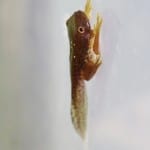 The couple set up large plastic tubs of water on their terrace dining table and separated the frogs by age – eggs, tadpoles, advanced tadpoles and froglets. At present, they have saved close to 600 eggs, and have already released 25 fully-developed frogs back into the rainforest at Portasol. See the video on Facebook.
The couple set up large plastic tubs of water on their terrace dining table and separated the frogs by age – eggs, tadpoles, advanced tadpoles and froglets. At present, they have saved close to 600 eggs, and have already released 25 fully-developed frogs back into the rainforest at Portasol. See the video on Facebook.
"We are very proud and thankful to have Gary and Shayne be part of Portasol's sustainable community. I am sure Mother Nature will be eternally grateful for their efforts to help preserve our Planet Earth," commented Portasol owner Guillermo Piedra.
Besides red-eyed tree frogs, another pet project of Kritzinger is to start "snake safari tours" at Portasol. "We're wildlife fanatics, and I am especially into snakes," he explained. He and Mrazek kept 18 snakes as pets in South Africa, and both are certified there for venomous snake handling and snake removal from houses. The couple hopes to lead tours at Portasol in the future for people to safely discover snakes and other wildlife. With Portasol's 1,300-acre rainforest development along the Portalón River Valley and 200-acre private reserve, there is plenty to see.
Article by Shannon Farley
Etiquetas:
living costa rica,
ocean view property costa rica,
rainforest costa rica,
sustainable community costa rica,
vacation rental costa rica,
vacation rental manuel antonio
Ubicación:
Portalón, Costa Rica
miércoles, 6 de noviembre de 2013
Suscribirse a:
Entradas (Atom)








